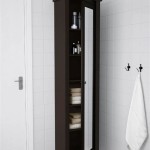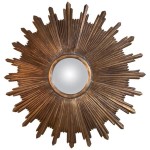How To Put A Mirror On A Wall Without Nails
Mirrors are essential decorative and functional items in any home. They enhance the aesthetic appeal of a room, create an illusion of spaciousness, and provide practical utility for daily grooming. However, the prospect of hanging a mirror, particularly a large or heavy one, can be daunting, especially if seeking to avoid the use of nails or screws. The potential for wall damage, difficulty in achieving precise placement, and concerns about the mirror's stability are common anxieties. Fortunately, several alternative methods exist for securely mounting a mirror without relying on traditional nailing techniques. These methods utilize various adhesives, tapes, and hanging systems designed to provide a strong and durable hold while minimizing or eliminating the risk of wall damage. This article provides a comprehensive guide to hanging a mirror without nails, outlining the necessary tools, materials, and step-by-step instructions for each method.
Before commencing any mirror-hanging project, careful consideration should be given to several crucial factors. The weight and size of the mirror are paramount, as they directly influence the selection of an appropriate mounting method. Larger and heavier mirrors necessitate stronger adhesive solutions and more robust support systems. Walls vary in their composition and structural integrity; therefore, understanding the wall’s material (drywall, plaster, concrete, etc.) is vital for choosing a compatible adhesive. Preparation is key to success. The wall surface must be clean, dry, and free from any loose paint or debris. Failing to properly prepare the surface can significantly compromise the adhesive's ability to bond effectively. Lastly, safety should always be a top priority. When handling mirrors, wear protective eyewear and gloves to prevent injury from accidental breakage. If the mirror is particularly large or heavy, enlist assistance to ensure safe lifting and positioning.
Selecting the Right Adhesive
Choosing the appropriate adhesive is critical for the safe and secure mounting of a mirror without nails. Several types of adhesives are specifically designed for this purpose, each possessing unique properties and suitability for different scenarios. Mirror mastic is a widely used option, offering exceptional adhesion strength and resistance to moisture and temperature fluctuations. It is particularly suitable for mounting mirrors in bathrooms or other high-humidity environments. Construction adhesive is another versatile choice, providing a strong and durable bond on various surfaces, including drywall, plaster, and wood. It is available in different formulations, so it is essential to select one specifically designed for mirror installation. Mounting tape, often referred to as double-sided tape, offers a convenient and mess-free alternative. It is available in various strengths and thicknesses, catering to different mirror weights. However, it is crucial to choose a high-quality mounting tape specifically designed for heavy-duty applications. Consider the long-term performance of the chosen adhesive. Factors such as temperature resistance, UV resistance, and potential for yellowing over time are relevant depending on the mirror's location and the desired aesthetic. It is recommended to consult the manufacturer's specifications and guidelines for each adhesive to ensure compatibility and optimal performance.
When evaluating adhesive options, it is essential to understand the difference between "removable" and "permanent" adhesives. Removable adhesives, typically in the form of mounting strips or tapes, are designed to be removed without causing significant damage to the wall surface. They utilize a lower-strength adhesive and often incorporate a release mechanism, such as a pull tab, to facilitate easy removal. These options are suitable for lightweight mirrors or temporary installations. Permanent adhesives, such as mirror mastic or construction adhesive, offer a much stronger and more durable bond. However, removing them can be challenging and may result in damage to the wall surface. These options are recommended for larger, heavier mirrors or installations where long-term stability is paramount. The selection between removable and permanent adhesives should be based on the specific requirements of the project, considering the mirror's weight, the desired longevity of the installation, and the potential for future removal.
Regardless of the adhesive chosen, testing the adhesive on an inconspicuous area of the wall is recommended before applying it to the entire mirror. This allows for assessing the adhesive's compatibility with the wall surface and identifying any potential issues, such as paint peeling or discoloration. Apply a small amount of adhesive to the test area, allow it to dry according to the manufacturer's instructions, and then attempt to remove it gently. If the adhesive removes easily without causing damage, it is likely suitable for the project. If it leaves residue or damages the wall surface, consider alternative adhesive options. Properly preparing the wall surface is equally important. Clean the area thoroughly with a mild detergent and water, removing any dirt, grease, or loose paint. Allow the surface to dry completely before applying the adhesive. A clean and dry surface will ensure optimal adhesion and a secure bond.
Applying Adhesives and Mounting Procedures
The application technique for adhesives varies depending on the type of adhesive chosen. For mirror mastic or construction adhesive, apply a generous amount to the back of the mirror in vertical beads, spaced several inches apart. Avoid applying adhesive to the edges of the mirror, as this can squeeze out and create a messy appearance. Position the mirror carefully against the wall, ensuring it is level and aligned correctly. Press the mirror firmly against the wall for several minutes, allowing the adhesive to make contact with the surface. Use painter's tape to secure the mirror in place while the adhesive cures. The curing time varies depending on the adhesive, so follow the manufacturer's instructions carefully. Avoid disturbing the mirror during the curing process. For mounting tape, apply strips of tape to the back of the mirror, spaced evenly apart. Ensure the tape covers a significant portion of the mirror's surface area. Remove the protective backing from the tape and carefully position the mirror against the wall. Press the mirror firmly against the wall for several minutes, ensuring the tape adheres securely. Mounting tape typically provides an instant bond, but it is still recommended to use painter's tape to secure the mirror in place for a few hours to allow the adhesive to fully set.
When mounting a large or heavy mirror, it is advisable to use additional support to prevent the mirror from sliding down the wall while the adhesive cures. One common method is to use a temporary support board positioned beneath the mirror. This board can be made from wood or other sturdy material and should be cut to the appropriate length to support the mirror's weight. Secure the board to the wall using painter's tape or temporary adhesive. Alternatively, use wedges or shims inserted between the mirror and the floor to provide support. Ensure the support system is stable and can safely bear the mirror's weight. Leave the support system in place until the adhesive has fully cured, as indicated by the manufacturer's instructions. Once the adhesive has cured, carefully remove the support system and inspect the mirror to ensure it is securely mounted. Gently shake the mirror to check for any signs of looseness or instability. If the mirror feels unstable, it may be necessary to add additional adhesive or consider alternative mounting methods.
For mirrors with pre-installed mounting hardware, such as D-rings or wire, consider using adhesive hooks or strips designed for hanging picture frames. These hooks and strips are available in various weight capacities and can be easily attached to the wall without nails. Select hooks or strips that are rated for the weight of the mirror, and follow the manufacturer's instructions for installation. Clean the wall surface thoroughly before applying the hooks or strips, and ensure they are securely attached. Hang the mirror onto the hooks or strips, ensuring the weight is evenly distributed. Regularly inspect the hooks or strips to ensure they remain securely attached and show no signs of loosening. This method is particularly suitable for lightweight mirrors or mirrors with pre-existing hanging hardware.
Alternative Hanging Systems
Beyond adhesives, several alternative hanging systems are available for mounting mirrors without nails. These systems often utilize specialized hardware and installation techniques to provide a secure and aesthetically pleasing solution. One popular option is the use of mirror clips. Mirror clips are small, metal or plastic brackets that are attached to the wall and hold the mirror in place. They are available in various styles and sizes, catering to different mirror thicknesses and designs. To install mirror clips, first, determine the desired placement of the mirror and mark the locations for the clips on the wall. Use a level to ensure the clips are aligned correctly. Attach the clips to the wall using screws or anchors, depending on the wall material. Slide the mirror into the clips, ensuring it is securely held in place. Mirror clips offer a clean and minimalist look and are suitable for various mirror sizes and shapes.
Another alternative is the use of French cleats. French cleats are interlocking strips of wood or metal that are attached to the wall and the back of the mirror. One strip is mounted horizontally on the wall, while the other strip is attached to the back of the mirror, with the angled faces interlocking. To install a French cleat, first, determine the desired placement of the mirror and mark the location for the wall-mounted cleat. Attach the cleat to the wall using screws or anchors, ensuring it is level and securely fastened. Attach the other cleat to the back of the mirror, ensuring it is aligned correctly with the wall-mounted cleat. Lift the mirror and slide the cleats together, engaging the interlocking faces. French cleats provide a strong and secure hold, allowing for easy removal and re-hanging of the mirror. They are particularly suitable for larger, heavier mirrors.
Suction cups are another method, though they are not recommend for long-term mounting, especially with heavier mirrors. Suction cups are designed to adhere to smooth, non-porous surfaces, such as glass or tile. They are typically used for smaller, lightweight mirrors or temporary installations. To use suction cups, clean both the suction cup and the mounting surface thoroughly. Moisten the suction cup slightly with water and press it firmly against the surface, ensuring all air is expelled. Test the suction cup to ensure it is securely attached before hanging the mirror. Suction cups are susceptible to losing their grip over time, so it is essential to check them regularly and reattach them as needed. This method is best suited for temporary or decorative applications.

3 Simple Ways To Hang A Mirror On Wall Without Nails Wikihow

How To Hang A Mirror On Wall Without Nails

How To Hang A Mirror On Wall Without Nails Guide For All Diyers

How To Hang A Heavy Mirror Without Nails 4 Alternative Ways Homelyville

3 Simple Ways To Hang A Mirror On Wall Without Nails Wikihow

How To Hang A Heavy Mirror At Home

Hang A Mirror Without Nails Diyer S Guide To Great Results

How To Hang A Heavy Mirror Without Nails Worst Room

3 Simple Ways To Hang A Mirror On Wall Without Nails Wikihow

How To Hang A Heavy Mirror Without Nails Worst Room








